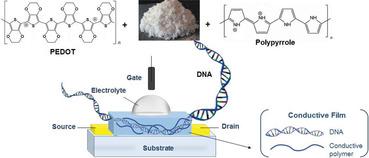当前位置:
X-MOL 学术
›
Adv. Mater. Technol.
›
论文详情
Our official English website, www.x-mol.net, welcomes your
feedback! (Note: you will need to create a separate account there.)
Conducting Polymer‐Based Biocomposites Using Deoxyribonucleic Acid (DNA) as Counterion
Advanced Materials Technologies ( IF 6.4 ) Pub Date : 2019-11-18 , DOI: 10.1002/admt.201900699 Serpil Tekoglu 1 , Dominik Wielend 1 , Markus Clark Scharber 1 , Niyazi Serdar Sariciftci 1 , Cigdem Yumusak 1
Advanced Materials Technologies ( IF 6.4 ) Pub Date : 2019-11-18 , DOI: 10.1002/admt.201900699 Serpil Tekoglu 1 , Dominik Wielend 1 , Markus Clark Scharber 1 , Niyazi Serdar Sariciftci 1 , Cigdem Yumusak 1
Affiliation

|
In this work, the preparation of conducting polymer‐based composites using a biological anionic polymer based on salmon deoxyribonucleic acid (DNA) is presented. The most commonly used polymers poly(3,4‐ethylenedioxythiophene) (PEDOT), as well as polypyrrole, are polymerized in the presence of DNA. Since conjugated polymers are in the polycationic state in their electrically conducting form, the role of the counterion is now fulfilled by the low cost biomolecule DNA as an alternative material, which is also a polyanion thanks to its phosphate chain. The resulting synthesized material is a conducting polymer–DNA biocomposite. Such materials are highly attractive for the rising field of bioelectronics and biosensors, especially in organic electrochemical transistors (OECTs) and ion pumps. OECTs made of these conducting polymer biocomposites are fabricated and their electrochemical device operation is compared to the most widely used PEDOT:polystyrenesulfonate.
中文翻译:

使用脱氧核糖核酸(DNA)作为抗衡离子来进行基于聚合物的生物复合材料
在这项工作中,介绍了使用基于鲑鱼脱氧核糖核酸(DNA)的生物阴离子聚合物制备导电聚合物基复合材料的方法。最常使用的聚合物聚(3,4-亚乙二氧基噻吩)(PEDOT)以及聚吡咯在DNA存在下进行聚合。由于共轭聚合物以其导电形式处于聚阳离子状态,因此抗衡离子的作用现在通过低成本的生物分子DNA作为替代材料来实现,由于其磷酸盐链,它也是一种聚阴离子。所得的合成材料是导电聚合物-DNA生物复合材料。这样的材料对于生物电子学和生物传感器的兴起领域具有高度吸引力,尤其是在有机电化学晶体管(OECT)和离子泵中。
更新日期:2020-03-09
中文翻译:

使用脱氧核糖核酸(DNA)作为抗衡离子来进行基于聚合物的生物复合材料
在这项工作中,介绍了使用基于鲑鱼脱氧核糖核酸(DNA)的生物阴离子聚合物制备导电聚合物基复合材料的方法。最常使用的聚合物聚(3,4-亚乙二氧基噻吩)(PEDOT)以及聚吡咯在DNA存在下进行聚合。由于共轭聚合物以其导电形式处于聚阳离子状态,因此抗衡离子的作用现在通过低成本的生物分子DNA作为替代材料来实现,由于其磷酸盐链,它也是一种聚阴离子。所得的合成材料是导电聚合物-DNA生物复合材料。这样的材料对于生物电子学和生物传感器的兴起领域具有高度吸引力,尤其是在有机电化学晶体管(OECT)和离子泵中。











































 京公网安备 11010802027423号
京公网安备 11010802027423号